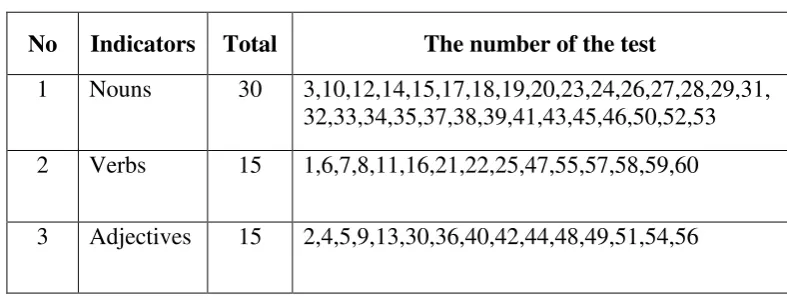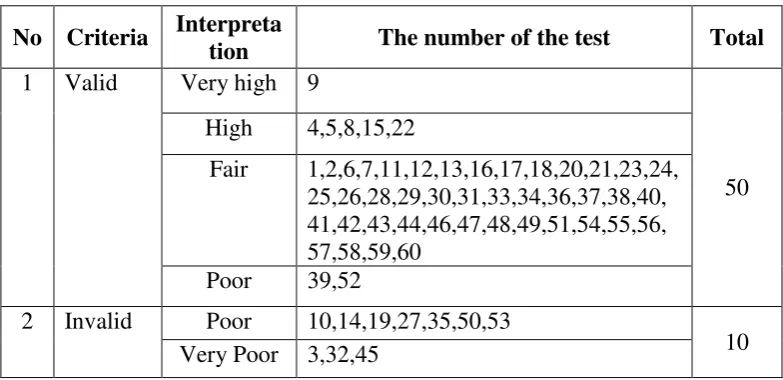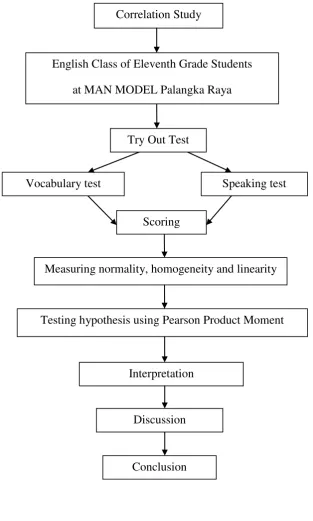33
In this chapter, the writer discussed about the research method which consisted of research type, research design, population and sample, data collection, research instruments, research instruments try out, research instruments reliability, research instruments validity, and data analysis.
A.Research Type
This research type of the study was quantitative research, because the writer
wanted to measure the correlation between students’ vocabulary mastery and speaking ability. This type was also being appropriate to collect statistical data to answer the problem of the study. Quantitative research used objective measurement to gather numeric data that are used to answer questions or test predetermined hypotheses.56
B.Research Design
The design of this study was nonexperimental design because the writer measured the correlation between students’ vocabulary mastery and speaking ability. In nonexperimental quantitative research, the writer identify variables and may look for relationships among them but does not manipulate the variables.57
This study is correlational research that gather data from individuals on two or more variables and then seeks to determine if the variables are related
56
Ibid, p. 23.
57
(positive correlation) or inversely (negative correlation). The degree of relationship is expressed as a numeric index called the coefficient of correlation.58
Correlational reseach has no manipulation of the variables. It provides information about the strength of relationship between variables. It also produces indexes that show both the direction and the strength of relationships among variables, taking into account the entire range of these variables.59
The writer chose this design because correlational design is aimed to measure if the variables are correlated. This is related to the objective of the study that was to measure the correlation between students’ vocabulary mastery and speaking ability.
C.Population and Sample 1. Population
A population is defined as all members of any well-defined class of people, events, or objects.60 The population in this study was all of the eleventh grade students of language class at MAN Model Palangka Raya. It consisted of 27 students, based on the documentation of MAN Model Palangka Raya.
58Ibid
, p. 27.
59
Ibid, p. 350.
60Ibid
Table 3.1 Number of population of eleventh grade students of language class at MAN Model Palangka Raya.
No. Class Number of the students
1. XI BAHASA 27 students
The Total Number 27 students
2. Sample
A sample is a portion of a population.61 The writer used total population sampling technique. Total population sampling is a type of purposive sampling technique, where you choose to examine the total population that have a particular set of characteristics.62So, the samples of this study were students taken from all of population of the eleventh grade students of language class at MAN Model Palangka Raya.
Table 3.2 Number of sample of eleventh grade students of language class at MAN Model Palangka Raya.
No. Class Number of the students
1. XI BAHASA 27 students
The Total Number 27 students
61Ibid
, p. 148.
62
D.Data Collection
The function of data collection was to determine the result of the research. The writer took some procedures in collecting data, they were :
1. Preparing the instruments to try out. 2. Giving the try out test to the students.
3. Collecing the students’ answers of the try out test. 4. Scoring the students’ answer sheets.
5. Analyzing the reliability and validity of the try out test. 6. Determining the class for being the sample of this study.
7. Giving the vocabulary test and then the speaking ability test to the sample class.
8. Collecting the students’ vocabulary test scores and their speaking test scores.
9. Analyzing the data by using Pearson Product Moment to answer the problem of the study.
10. Interpreting the result of analyzing data. 11. Concluding the data.
Table 3.3 The sources of the data and the data needed.
E.Research Instruments Try Out
Try out is used to measure the suitability of the test and the students’ ability
in the sample class of this study, so the writer conducted a try out test. The writer chose the students in the same school but different classes to try out the test and collected the students’ answers for giving scores, and analyzed the score to get the instruments reliability and validity of test. There were two kinds of test that had been given to students, both were vocabulary test and speaking test. The vocabulary test consisted of 60 items in form of multiple choices and the time allocation for answering the test was 60 minutes. The speaking test consisted of the instructions for the subjects to choose one of the topics that was interested and talked about the topic in form of spoken (monologue) about 3-5 minutes. The try out test was at the eleventh grade students at MAN Model Palangka Raya, the try out class was XI Ilmu Agama with 30 students.
Table 3.4 Specification of vocabulary try out test items.
No Indicators Total The number of the test
1 Nouns 30 3,10,12,14,15,17,18,19,20,23,24,26,27,28,29,31, 32,33,34,35,37,38,39,41,43,45,46,50,52,53 2 Verbs 15 1,6,7,8,11,16,21,22,25,47,55,57,58,59,60
3 Adjectives 15 2,4,5,9,13,30,36,40,42,44,48,49,51,54,56
validity, index difficulties, and reliability. The speaking try out test analysis consisted of the reliability of the try out test.
1. Items validity of the vocabulary try out test
The writer used the Pearson Product Moment calculation to measure the validity of the vocabulary try out test items. The vocabulary try out test was given twice and the results of the calculation were presented in the following tables: Table 3.5 The result of items validity of the first vocabulary try out test.
No Criteria Interpreta
2 Invalid Poor 10,14,19,27,35,50,53
10 Very Poor 3,32,45
Based on the table above, it can be concluded that the result of the first vocabulary try out was 50 items were valid and 10 items were invalid.
Table 3.6 The result of items validity of the second vocabulary try out test.
2 Invalid Poor 3,10,35,45,50,
9 Very Poor 14,27,32,52,
Based on the table above, it can be concluded that the result of the second vocabulary try out was 51 items were valid and 9 items were invalid.
2. Index difficulties of vocabulary try out test
The test is difficult if the students were not able to answer the test, index difficulties is used to know whether the test is difficult, easy, or fair for the students. The vocabulary try out test was given twice and the result of the calculation was presented in the following table:
Table 3.7 The result of index difficulties of the vocabulary try out test.
3. Reliability of vocabulary try out test
The writer used test-retest procedure to analyze the reliability of the vocabulary try out test. To measure the reliability, the Pearson Product Moment calculation is used to know whether the test is reliable or not. The result of the reliability calculation of the vocabulary try out test based on the data obtained was 0.702 at high criteria level of reliability.
No Vocabulary try out Criteria Total Total items
1 Test 1 Easy 0
60
Fair 60
Difficult 0
2 Test 2 Easy 0
60
Fair 60
4. Reliability of speaking try out test
The writer used inter-rater procedure to analyze the reliability of the speaking try out test. To measure the reliability, the Pearson Product Moment calculation is used to know whether the test is reliable or not. The result of the reliability calculation of the speaking try out test based on the data obtained was 0.964 at very high criteria level of reliability.
F. Research Instruments
A research instrument was a survey, test, scale, rating, or tool designed to measure the variables, characteristics, or information of interest, often a behavioral or psychological characteristic. Research instruments could be helpful tools to the research study. In this study, the instruments was test.
A test is a set of stimuli presented to an individual in order to elicit responses on the basis of which a numerical score can be assigned.63 There were two kinds of test used in this study, the first one was to measure the students vocabulary mastery, and the second was to measure their speaking ability.
The vocabulary test consisted of 45 items in form of multiple choices questions and the students answered the test in 45 minutes.The test items were adapted from English books that used in the school and other resources, the test items were limited to some of the parts of speech, as nouns, verbs, and adjectives. According to James Milton, part of speech can also play a role in influencing the learning burden of a word. Nouns, it seems, are easier to learn than verbs, which
63
are easier than adjectives.64 The common parts of speech that learned at the school was also nouns, verbs, and adjectives as they were easier to learn and remembering as words.
The speaking ability test consisted of the instruction and statement the subjects addressed in their speaking and the alternative topics to be chosen. In this sense, the students were assigned to choose one of the topics that was interested. They were asked to develop the topic in form of spoken (monologue) about 3-5 minutes. The students’ performances were scored by two raters, the one of English teacher and also the writer self, then calculated to get the mean of the two
raters’ scores. The final score were related to the following qualification based on KKM for English subject at eleventh grade students of MAN Model Palangka Raya.
Table 3.8 Qualification scores for English subject.
Score Criteria
81 – 100 < 80
Pass Fail
Table 3.9 Specification of vocabulary test items.
No Indicators Total The number of the test
1 Nouns 15 12 ,17,18,20,23,24,28,29,31,33,34,37,38,41,43
2 Verbs 15 1,3,6,7,8,10,11,16,19,21,22,25,26,27,35
64
3 Adjectives 15 2,4,5,9,13,14,15,30,32,36,39,40,42,44,45
G.Research Instruments Reliability
Reliabilityis the degree of consistency with which it measures whatever it is measuring. This quality is essential in any kind of measurement.65 The good instrument in a study is not only the instrument valid, but also reliable to measure what suppose to be measured. The instrument should be consistent when is measured.
The reliability procedures of this study were inter-rater reliability for speaking test, and test-retest reliability for vocabulary test. For inter-rater
reliability of speaking test, two raters employed to score the students’ speaking
ability. The two rater were the writer self and one of English teacher of MAN Model Palangka Raya. One important thing in using the inter rater method in rating process is focused with the training of the raters. It can maximize the accuracy of the speaking assessment. For test-retest reliability of vocabulary test, obtained by administering the same test twice over a period of time to a group of individuals. The score from time 1 and time 2 can then be correlated in order to evaluate the test for stability over time.
Inter-rater reliability is the consistency of the judgment of several raters on how they see a phenomenon or interpreted the responses of the subject. It indicates accuracy in scoring composition of two different raters.
65Ibid
Relevant to this, Nunan stated that the acceptance reliability on composition score is possible to get through careful training of raters.66 Furthermore, Latief argued that reliability on composition is affected by both raters and writers of the
text. Raters’ reliability refers to the accuracy of the raters’ judgment. Meanwhile,
writers’ reliability refers to the accuracy of the writers’ performance.67
To obtain inter- rater reliability, the score of two raters were correlated using Pearson Product Moment Correlation. Then the writer got the interpretation of coefficient correlation, whether they belonged to high, moderate, positive, weak or negative inter rater reliability category.
H.Research Instruments Validity
Validity was defined as the extent to which an instrument measured what it claimed to measure.68 Validitywas the extent to which an instrument measured what it is supposed to measure and performed as it is designed to perform. As a process, validation involved collecting and analyzing data to assess the accuracy of an instrument. The focus of validity was not on the instrument it self but on the interpretation and meaning of the score derived from the instrument.
Validity was crucial to fair and meaningful vocabulary and speaking assessments. In constructing the instrument, the writer considered the validity of the test. To make the instrument became valid, it had been approved by the real teacher on this research. To validate the result of the test, the writer asked the real
66
David Nunan, Research Methods in Language Learning, Cambridge: Cambridge University Press,1992 p. 56.
67
M. Latief Adnan, Reliability of Language Skill Assessment Result, Jurnal Imu Pendidikan VIII No. 3, 214-224, 2010.
68
teacher to analyze it. The writer analyzed the result based on the suggestion of the real teacher.
1. Face Validity
The types of face validity, if the test items looked right to other testers, teacher, indicators and test. The types of test items used in this study can be suitable to the others at the same level with Senior High School. For face validity of the test items were as follows:
a. The test used written form in writing test instruction.
b. The evaluation of vocabulary and speaking test based on scoring system. c. The language of items used English.
d. The test was suitable with the syllabus of English subject for eleventh grade at MAN Model Palangka Raya.
2. Construct Validity
Construct validity is type of validity which assumed the existence of certain learning theories or construct underlying the acquistion of abilities and skills. In this study, the test was written in order to measure the students’ vocabulary mastery and spoken in order to measure students’ speaking ability.
3. Content Validity
items and the course objective always being apparent.69 The instrument used was test, the testing of content validity was done by asking the opinion to the teacher of the subject and matching with the curriculum that was used by MAN Model Palangka Raya.
I. Data Analysis
1. Technique of Analyzing Data
The writer used the correlational technique in analyzing data. The correlation technique is analyzing technique to evaluate the correlation between two variables that examined statistically. To complete the data analysis, there were some tests that were done before testing the hypotheses: normality,
level of significance α=5%. Calculation result of asymptotic significance is higher
than α(5%) so the distribution data was normal. In the contrary, if the result of
asymptotic significance is lower than α (5%), it meant the data was not normal distribution.70
b. Homogeneity Test
Homogeneity is used to know whether the sample, that are decided, comes
69
J.B. Heaton, Writing English Language Tests ,London: Longman Group Limited, 1975, p. 154.
70
from population that has relatively same variant or not. To calculate homogeneity testing, the writer applied SPSS 16 program using Levene’s testing with level of
significance α (5%).
If calculation result is higher than 5% degree of significance so Ha was accepted, it means both groups have same variant and homogeneous.71
c. Linearity Test
It is used to know whether the variables are correlated linearly or not. The linearity test is usually used for the correlational analysis. It is tested by using SPSS program (test for linearity) with the level of sigificance is 0,05. The variables are correlated linearly if the calculation result of probability is < 0,05.
d. Testing Hypotheses
In the correlation technique, the variables were compared to know whether the correlation was very significant or it only happened by chance.
Correlations indicate the relationship between paired scores. The correlation indicates whether the relationship between paired score is positive or negative and the strength of this relationship. In addition to looking at correlation through visual means, the writer can calculate a correlation coefficient that represents the correlation with the Pearson Product Moment Correlation Coefficient.72
In this study, the writer used Pearson Product Moment test to find out the correlation score of students’ vocabulary and speaking ability.73
71
Analisis Data dengan SPSS, http://pasca.undiksha.ac.id/elearning/staff/dsnmateri/4/1-45.pdf. (Online 24 June 2014).
72
Donald Ary, Lucy Cheser Jacob, Chris Sorensen, Asghar Razavieh, Introduction to Research in Education, 8 ed, p. 128.
73
r
XY=
𝑛 𝑋𝑌 − 𝑋 . 𝑌
𝑛. 𝑋2− 𝑋 2 . 𝑛. 𝑌2− 𝑌 2
2. Data Analysis Procedures
The writer did some ways in the data analysis procedure, they were as follows:
1) Collecting students’ vocabulary and speaking scores of test.
2) Arranging the obtained score into the distribution of frequency of score table.
3) Measuring the normality, homogeneity and linearity.
4) Analyzing the data by using Pearson Product Moment to answer the problem of the study. In addition, the SPPS program was applied. 5) Interpreting the result of analyzing data.
6) Making discussion to clarify the research finding. 7) Giving conclusion.
8) Summarizing.
Figure 3.1 Steps of collecting data, data analysis procedures, and testing hypothesis.
Correlation Study
Speaking test Vocabulary test
Scoring
Measuring normality, homogeneity and linearity
Testing hypothesis using Pearson Product Moment
Interpretation
Discussion
Conclusion
English Class of Eleventh Grade Students at MAN MODEL Palangka Raya



